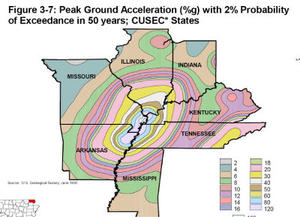DisastersFifteen U.S. nuclear reactors are located in an active seismic zone
There are 104 nuclear plants in the United States, and fifteen of them are located in what is known as the New Madrid Seismic Zone, a region defined by a fault line of the same name; the New Madrid Seismic Zone involves eight states, and it is an active earthquake area in the central United States that follows the Mississippi River between Missouri, Kentucky, Arkansas, and Tennessee; while the U.S. earthquake zone is active, scientists say the ingredients do not exist there for a Japan-style nuclear disaster; should a large seismic event strike this part of the country, seismologists offer Christchurch, New Zealand, rather than Japan as an example of what to expect. In February, Christchurch suffered a 6.3 magnitude quake and billions of dollars in losses

The New Madrid Seismic Zone // Source: showme.net
There are 104 nuclear plants in the United States, and fifteen of them are located in what is known as the New Madrid Seismic Zone, a region defined by a fault line of the same name. While the U.S. earthquake zone is active, scientists say the ingredients do not exist there for a Japan-style nuclear disaster.
“There is that uncertainty when you hear that something has happened because you don’t understand,” said Jeff King, interim director of the Nuclear Science and Engineering Program at the Colorado School of Mines. “I would say Americans should actually be very comfortable (about) those plants.”
King, a former Department of Energy nuclear facility on-site inspector, is not working directly with officials on the Japan disaster, and he noted that it will be some time before a final report is completed.
He told Fox News that the early diagnosis for the nuclear accident in Japan had more to do with the tsunami that followed the 11 March earthquake and the power loss to the Fukushima Daiichi nuclear facility than the 8.9 magnitude temblor.
“The distinction, the earthquake and the tsunami is kind of an important one,” he said. “The plant survived the earthquake with minimal problems, there’s some questions about the spent fuel pools, but minimal problems, and then it was an hour later when the tsunami hit and they lost all of the their backup power.”
Fox News reports that DHS is scheduled to conduct a large-scale, interagency disaster response exercise in the New Madrid Seismic Zone this spring. It is an annual exercise held by the federal government, and Homeland Security secretary Janet Napolitano’s office said the location of this year’s drill is not connected to events in Japan.
“With respect to the United States, we are constantly practicing” disaster response, Napolitano recently told an audience in Denver.
Robert Williams, a scientist with the U.S. Geological Survey’s Hazards Team, said the New Madrid Seismic Zone involves eight states, and it is an active earthquake area in the central United States that follows the Mississippi River between Missouri, Kentucky, Arkansas, and Tennessee.
“It’s an area that is currently experiencing earthquakes and has a history of magnitude 7 to 8 earthquakes,” Williams said. “But the shaking from a New Madrid quake would involve a much larger area. So it runs along that border and it’s of concern to those communities in the Mississippi River valley as well as Memphis and St. Louis.”
Should a large seismic event strike this part of the country, seismologists offer Christchurch, New Zealand, rather than Japan as an example of what to expect. In February, Christchurch suffered a 6.3 magnitude quake and billions of dollars in losses.
“Christchurch has a building infrastructure that’s a lot like what you find in the central U.S. main street, 100-year-old brick buildings, no reinforcement, no consideration of earthquake shaking,” Williams said.
King, who used to live in the New Madrid region, agreed that infrastructure outside the nuclear plants is the bigger concern. “If I still lived in that area, my biggest worry would be the loss of my utilities, the loss of my power and water,” he said. “The real tragedy in the case of a natural disaster is going to be the natural disaster, not the nuclear power plant.”
